Knowing how to clean up (or clarify) used cooking oil will help you get the most use out of leftover oil after frying, searing, or sauteeing. Use the oil for your next batch of Fried Ravioli or Country Fried Pork!

How to Clean Used Cooking Oil
Have you ever wondered, can I reuse cooking oil? Or how many times have you fried something, had a lot of oil leftover, and not known what to do with it?
It’s not wise to pour it down the drain (bad for the pipes) or add it to compost. So, what do you do with it? You can reuse it! Yep, with this method, you can clarify the oil and use it several more times!
If your oil has ever looked like this⬇️, you are in the right place!
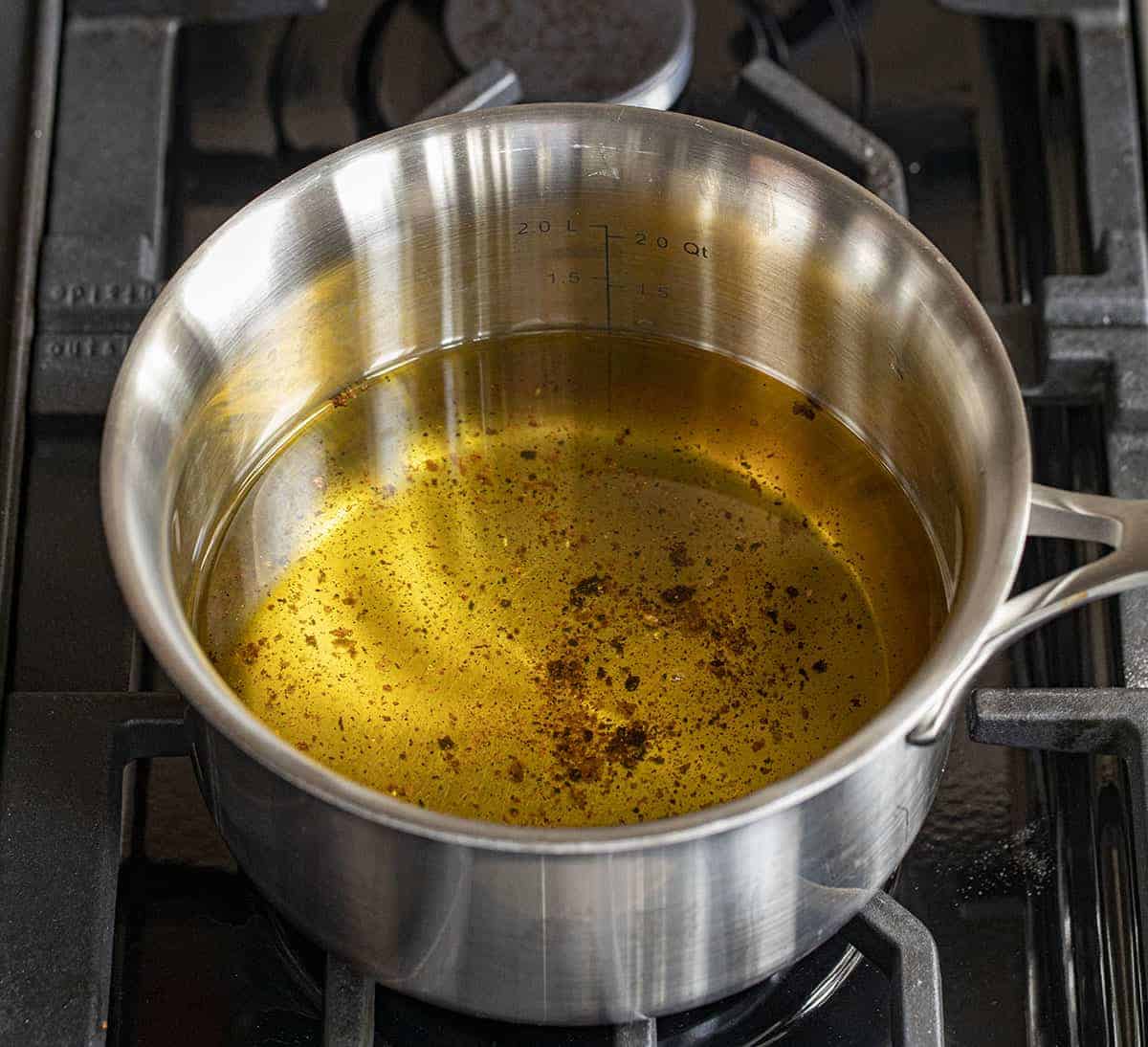
Ingredients
Oil: I tested vegetable oil for this method. I do not recommend other oils with this method, such as olive or avocado.
Slurry: The water and cornstarch slurry will come together when added to the oil to collect all the debris in the used oil.
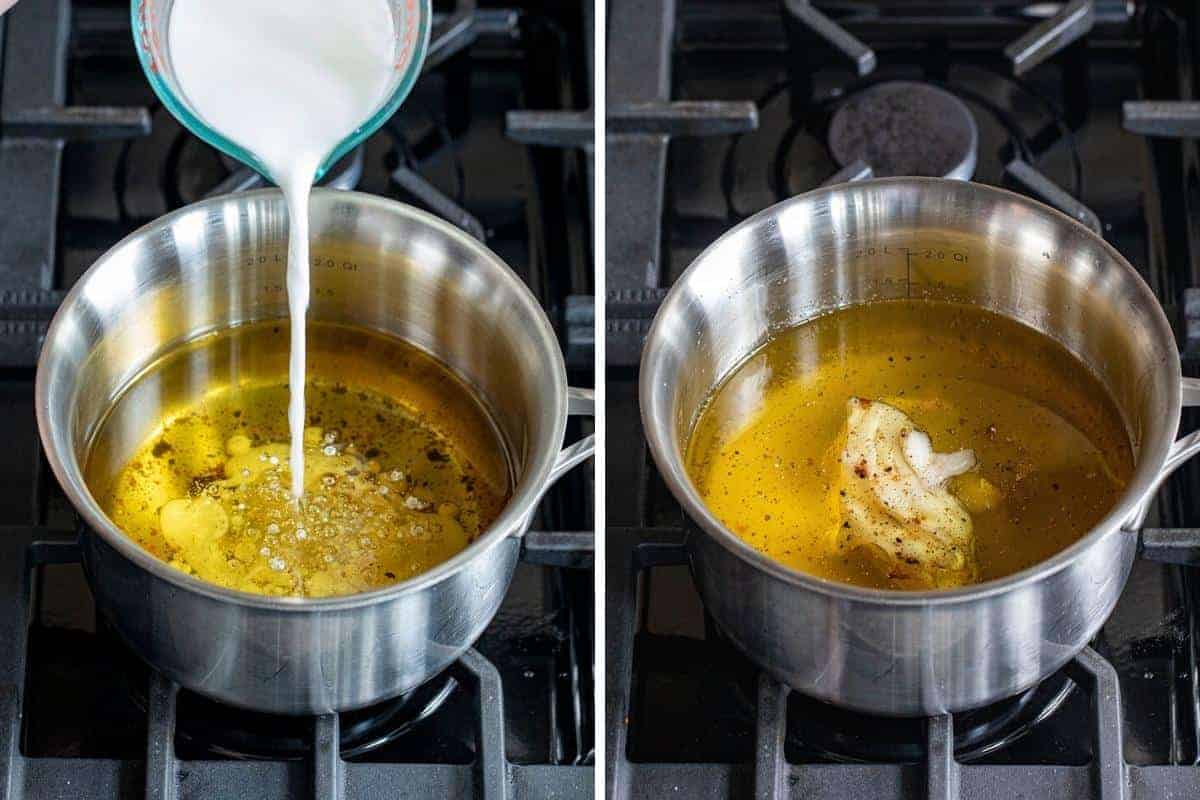
Recipe Equation
You may notice in the recipe below that it starts with 1 cup of oil, 1/4 cup water, and 1 tablespoon cornstarch. That is the base amount, but you’ll often have more! To use this equation, just measure how much oil you have in cups and then multiply by that number.
For instance, if you have 5 cups of oil, that would equal 1 1/4 cups water and 5 tablespoons cornstarch.
If you have 1 quart of oil (4 cups) it will be 1 cup of water and 4 tablespoons of cornstarch.
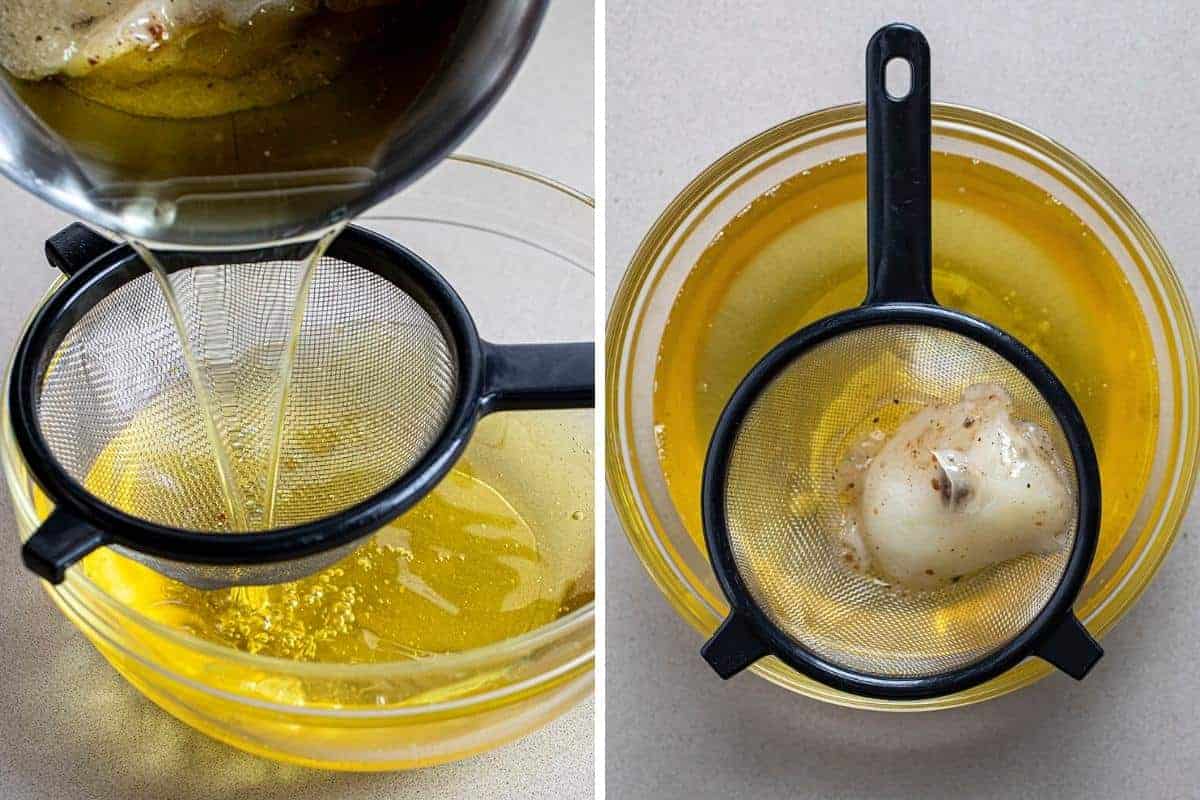
What Does the Cornstarch Do?
Are you wondering… just how does this work?
Using a cornstarch slurry when clarifying oil helps collect all the debris from whatever you were frying or cooking in the oil. The slurry will be put into the used oil and heated up until the cornstarch becomes solid. Once you pour the oil and cornstarch through a strainer, the solid cornstarch will be left behind, leaving you will the ready-to-use cooking oil!
Does it Matter What Was Fried in the Oil?
Oil takes on the flavor of whatever you fry in it, so it is a good idea to fry similar items in previously-used oil. Yes, even if it has been clarified with the method I am sharing here. For example, don’t fry donuts in catfish oil.
How to Store Clarified Oil
First off, be sure to label your clarified oil with how many times you have clarified it as well as what you fried in the oil. “1st Clarify, Used for Chicken, 5-21-22” If stored properly, clarified oil can last up to a year.
There are a few storage options for storing used oil. One option is to store it in a sealed container in a cool, dark spot at room temperature. A second option would be to store the oil in the refrigerator. The third option would be to store the oil in the freezer. This will give the oil a longer shelf-life. To use, remove the oil from the freezer and allow it to come to room temperature before using. It should not be cold.
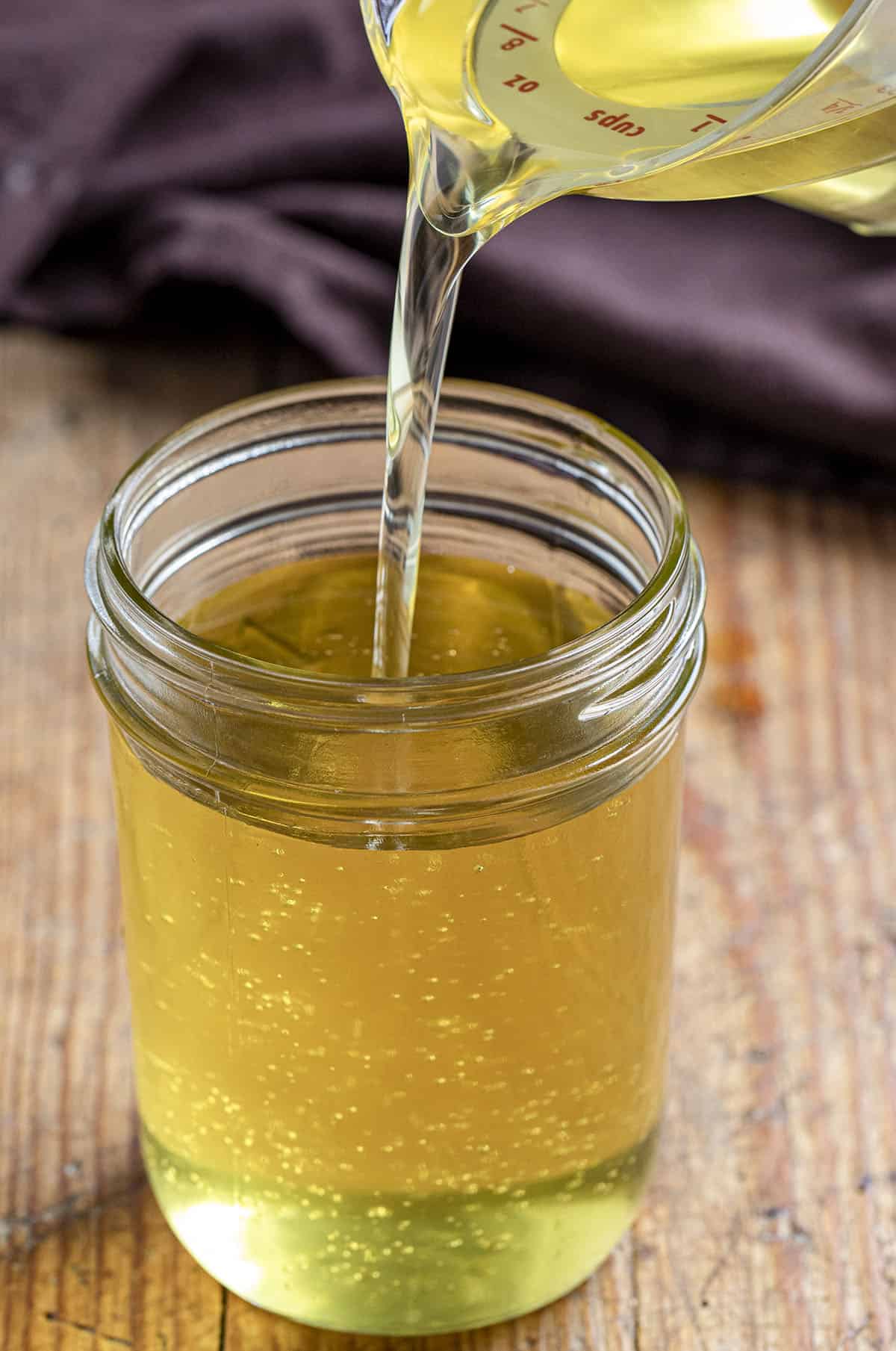
How Long Will Clarified Oil Last?
Although I stated you could reuse the oil up to three times, it does depend on what you are frying or using the oil for. Three reuses are generally the minimum number of times, regardless of what you are frying. However, if the oil ends up with a greasy odor, turns brown, or smokes easily, it’s time to toss it.
Simplest Method For Cleaning Used Oil
If you are short on time and planning on frying a similar recipe in the used oil, you can simply strain it. Just pour the oil over a pot that has a fine strainer and is lined with a few layers of cheesecloth or coffee filters. This gets out the large chunks and burnt bits.
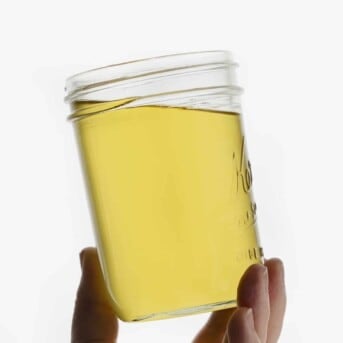
How to Clarify Used Cooking Oil
Ingredients
- 1 cup used cooking oil, cooled
- ¼ cup water
- 1 tablespoon cornstarch
Instructions
- Place a fine-mesh strainer over a heat-safe bowl and set aside.
- In a small dish, whisk together water and cornstarch to create a slurry. Set aside.
- Pour your used cooking oil into a large pot.
- Pour the cornstarch slurry into the pot with the used cooking oil.
- Heat this mixture over low heat. (You don't want it to simmer.) Occasionally, stir and scrape the bottom of the pot. This process takes about 10-12 minutes. You know it is done when the cornstarch has all come together, becomes a solid, and has collected all of the debris.
- Remove oil from heat and pour it into the fine mesh strainer. (You can also use a couple of layers of cheesecloth.)
- Discard the cornstarch mixture.
- Allow the oil to cool completely before storing. The oil will look cloudy at first but will settle as it cools.
- Refrigerate the clarified oil.
Notes
Did you make this recipe?
You can tag me at @iamhomesteader.
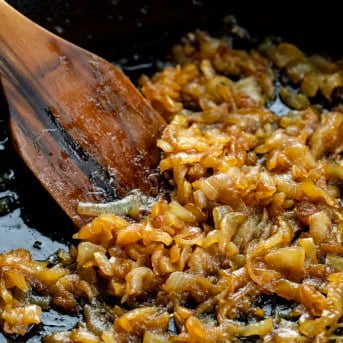

Can you just strain the oil in an old white cup towel? My Mama when I was little used to strain fresh milk that way!
“vegetable oil” is a category, not a thing. It is generally a mixture of several different oils, which can vary greatly . What is your reason for excluding oils such as avocado? Is it simply because you haven’t tested anything else?
You’re absolutely correct—’vegetable oil’ is indeed a category and can include a variety of oils. For this post, I focused on common, widely available options typically referred to as vegetable oil blends, which are frequently used in everyday cooking. I didn’t include oils like avocado oil simply because they have different smoke points and properties, which may affect how well this method works. If you give it a try with other oils, I’d love to hear about your results!
What an interesting idea. I am 80+ and never knew about reusing oil. However, my mom always saved the bacon grease for cooking her vegetables, especially greens, string beansand and hard soup beans. Always tasted good!!
Would appreciate an actual temperature reading on the oil prior to adding the slurry. Thanks!
Sure –
“Heat this mixture over low heat. (You don’t want it to simmer.) Occasionally, stir and scrape the bottom of the pot. This process takes about 10-12 minutes. You know it is done when the cornstarch has all come together, becomes a solid, and has collected all of the debris.”
I enjoy the fact you stuck up for the article Amanda.
One of the few things that actually worked for me. And so much easier to
clean up afterwards! I’m going to share it with family and friends.
Thank you VERY much!!!
Hi thank you for the information on how to reuse the oil. I always throw it away. I alway feel bad for wasting it. I’m also going to try the banana bits for Father’s Day it sounds delicious. Please don’t let haters bother you. Sometimes I think they don’t have anything else better to do!!! I do love your recipe 😋
I like this information. It works!
Worked fine for me. I had used the oil (in an old Fry Daddy) twice previously for fried chicken tenders. My oil was probably hotter than what you recommend but I had no problems. I scooped out the fried corn starch with a slotted ladle onto paper towels and threw it in the trash can. Then I fried some chicken breast strips to put in the oven with a couple cans of evaporated milk. Makes a really good milk gravy with the breading bits that fall from the strips into the milk as you turn the chicken. Great on whipped potatoes.
Thank you.
So just strain it I don’t need cheese cloth?.That’s a good ideas for those tenders
Canola oil is horrible for you. It should be thrown in the trash and never used. Avocado oil is good for high temp cooking, but due to the breaking down process with heat, no oil should ever be reused. Look up how canola and vegetable oil is made on YouTube and I bet you will never eat again! It is extracted and deodorized and bleached and likely rancid before it ever even gets to you. The Omega6 ratio is dangerous and these oils are a direct contributing factor in heart disease and even cancer.
Please feel free to go and complain on Canola Oil’s page. I don’t know why you think its okay to attack me for using an ingredient that you disagree with. It’s immature.
Some people just have nothing better to do than find fault with others. I appreciate your tips, and enjoy your recipes. Keep up the good work!
Good for you, Amanda!
Instead of being helpful or just not commenting at all, Rhonda was simply being hateful.
You could call out plenty other preparations, she’s just showing how to clean up the oil, you feel that strongly then start a thread and I’d be careful saying it causes cancer unless you have proof from verifiable sources that has peer reviewed data.